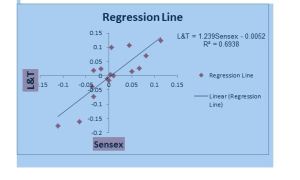Hope you like my last article on risk premium. The last things that is required to calculate cost of equity is Beta. It basically measures the extent to which stocks move with respect to the market portfolio. For example: – Beta value of 1 for a particular stock shows that it behaves in the same way as the market portfolio.
Generally Beta can be calculated by using three methods. Firstly by using historical data, secondly through fundamentals and thirdly by using accounting methods. All methods have their own advantages as well as disadvantages. I will discuss all the three methods one by one in my blogs. Let’s start up with the calculation of Beta with the help of Historical return.
This is the conventional approach for estimating betas used by most services and analysts. For firms that have been publicly traded for a length of time, it is relatively straightforward to estimate returns that an investor would have made on its equity in intervals (such as a week or a month) over that period. The standard procedure for estimating the CAPM beta is to regress stock returns (Rj) against market returns (Rm) .It is given by
Rj = a + b Rm
where
a = Intercept from the regression
b = Slope of the regression = Covariance (Rj, Rm) / σ2
The slope of the regression corresponds to the beta of the stock and measures the riskiness of the stock. This slope, like any statistical estimate, comes with a standard error, which reveals just how noisy the estimate is, and can be used to arrive at confidence intervals for the “true” beta value from the slope estimate.
There are three decisions the analyst must make in setting up the regression described above. The first concerns the length of the estimation period. The trade-off is simple: A longer estimation period provides more data, but the firm itself might have changed in its risk characteristics over the time period. The second estimation issue relates to the return interval. Returns on stocks are available on an annual, monthly, weekly, daily and even on an intra-day basis. Using daily or intra-day returns will increase the number of observations in the regression, but it exposes the estimation process to a significant bias in beta estimates related to non-trading. For instance, the betas estimated for small firms, which are more likely to suffer from non-trading, are biased downwards when daily returns are used. Using weekly or monthly returns can reduce the non-trading bias significantly.
The third estimation issue relates to the choice of a market index to be used in the regression. In most cases, analysts are faced with a mind-boggling array of choices among indices when it comes to estimating betas such as BSE 200, Sensex, Nifty etc. One common practice is to use the index that is most appropriate for the investor who is looking at the stock.
| Month | L&T | Sensex |
| Jan-10 | -0.160747939 | -0.063839139 |
| Feb-10 | 0.09954386 | 0.005522262 |
| Mar-10 | 0.026088328 | 0.066266588 |
| Apr-10 | -0.016450084 | 0.000209057 |
| May-10 | 0.017875 | -0.033770584 |
| Jun-10 | 0.107289685 | 0.044743437 |
| Jul-10 | 0.001169916 | 0.010687616 |
| Aug-10 | 0.003571429 | 0.003339231 |
| Sep-10 | 0.123461538 | 0.113273779 |
| Oct-10 | -0.011175234 | -0.003073539 |
| Nov-10 | -0.038535503 | -0.037057115 |
| Dec-10 | 0.014871414 | 0.050133154 |
| Jan-11 | -0.175301508 | -0.111235253 |
| Feb-11 | -0.073909091 | -0.032660739 |
| Mar-11 | 0.070064725 | 0.081354533 |
| Apr-11 | 0.024182418 | -0.017534711 |
Source: BSE India
Estimation of Beta with the help of an Example
From the table we will do the regression analysis by using scatter plot as shown in the figure. The slope of the regression line will give the value of Beta which is equal to 1.239. But this beta is not free from error. Suppose the standard error is .20. Hence the value of beta lies in between 1.039 to 1.439 for 67 % confidence interval and .839 to 1.639 for 95 % confidence interval.
Generally most of the Analysts use the value of beta find out by agencies such as Bloomberg, Wall Street, S&P etc. But again their value varies according to time frame, index selection and interval to calculate the value of beta as explained above.
Hope this article to calculate the value of beta by using historical data helps you. Be ready to learn two different ways to calculate beta in my next blog.

